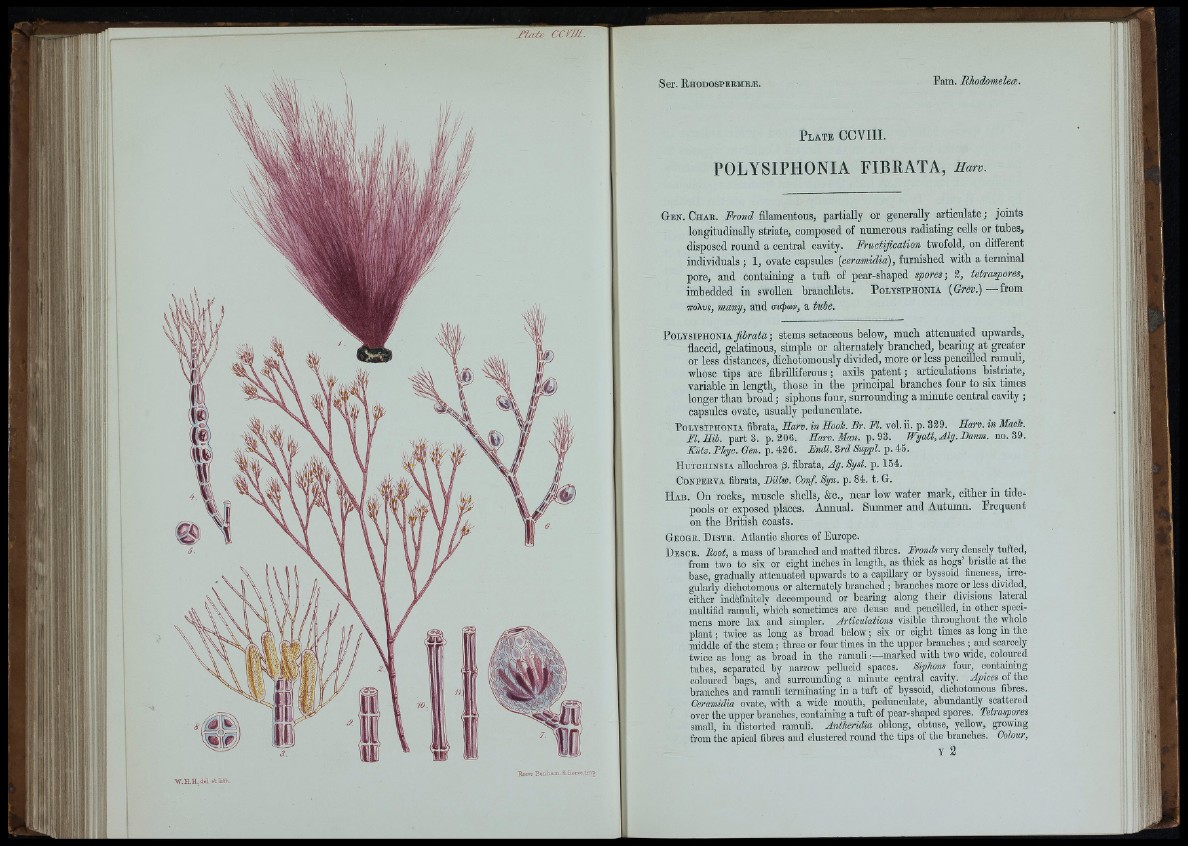
Keeve.Berikam &- iUeve.imp
P l a t e CCVIII.
POLYSIPHONIA FIBRATA, Harv.
G e n .C h a r . Frond filamentous, partially or generally articulate; joints
longitudinally striate, composed of numerous radiating cells or tubes,
disposed round a central cavity. Fructification twofold, on different
individuals ; 1, ovate capsules (ceramidia), furnished with a terminal
pore, and containing a tuft of pear-shaped spores; 3, tetraspores,
imbedded in swollen brancMets. P o ly s i p h o n i a (G re v .)— from
iroXtis, many, and aaj>oiv, a tuie.
P o l y s i p h o n i a ; stems setaceous below, much attenuated upwards,
flaccid, gelatinous, simple or alternately branched, bearing at greater
or less distances, dichotomously divided, more or less pencilled ramuli,
whose tips are flbriUiferous ; axils patent ; articulations bistriate,
variable in length, those in tbe principal branches four to six times
longer than broad ; siphons four, surrounding a minute central cavity ;
capsules ovate, usually pedunculate.
P olysiphonia fibrata, Harv. in Hook. Br. M. vol.ii. p. 339. Harv. in Mack.
J'Z. ÆS5. part 3. p. 306. Harv. Man. p . 93. Wyatt,Alg.Banm. ao.39.
Kütz. Phyc. Gen. p. 426. Kndl. 3rd Suppl. p. 45.
H utohinsia allochroa S- fibrata, Ag. Syst. p. 154.
Conferva fibrata, BiUto. Conf. Syn. p. 84. t. G.
H a b . On rocks, muscle shells, &o., near low water mark, either in tide-
pools or exposed places. Annual. Summer and Autumn. Frequent
on the British coasts.
Geogr. D is t r . Atlantic shores of Europe.
D e sc r . Boot, a mass of b ranched and m atted fibres. Frotids very densely tufted,
from two to six or eight inches in length, as thick as hogs bristle a t the
base, gradually attenuated upwards to a capillary or byssoid fineness, irregularly
dichotomous or alternately branched ; branches more or less divided,
either indefinitelv decompound or bearing along their divisions lateral
multifid ramuli, which sometimes are deuse and pencilled, in other specimens
more lax and simpler. Articulations visible tlu-oughout the whole
p la n t; twice as long as broad below; six or eight times as long in the
middle of th e stem ; three or four times in the upper branches ; and scarcely
twice as long as broad in the ramuli :— marked with two wide, coloured
tubes, separated by narrow pellucid spaces. Siphons four, containing
colom-ed bags, and surrounding a minute central cavity. Apices of the
branches and ramuli terminating in a tu ft of byssoid, dichotomous fibres.
Ceramidia ovate, with a wide mouth, pedunculate, abundantly scattered
over the upper branches, contaming a tu ft of pear-shaped spores. Tetraspores
small, in distorted ramuli. Antheridia oblong, obtuse, yellow, growing
from the apical fibres and clustered round the tips of the branches. Colour,
Y 2